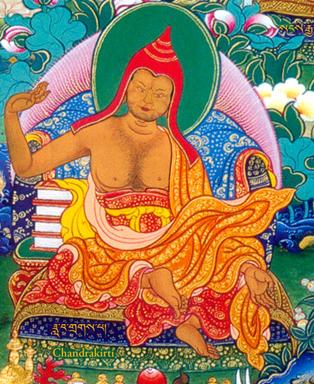Difference between revisions of "Candrakīrti"
| Line 1: | Line 1: | ||
[[Image:Chandrakirti.JPG|frame|Chandrakirti]] | [[Image:Chandrakirti.JPG|frame|Chandrakirti]] | ||
| + | |||
| + | |||
| + | |||
| + | |||
| + | |||
| + | |||
| + | |||
[[Chandrakīrti]] (600–c. 650), ({{Wiki|Devanagari}}: [[चन्द्रकीर्ति]]; {{Wiki|Chinese}}: [[月称]] [[Yuèchēng]]; {{Wiki|Japanese}}: [[月称]] [[Gesshō]]; [[Tibetan]]: {{BigTibetan|[[ཟླ་བ་གྲགས་པ]]}}) was an [[Indian]] [[scholar]] at [[Nālandā]] [[vihara|Mahāvihāra]]. He was a [[disciple]] of [[Nāgārjuna]] and a commentator on his works and those of his main [[disciple]], [[Aryadeva|Āryadeva]]. | [[Chandrakīrti]] (600–c. 650), ({{Wiki|Devanagari}}: [[चन्द्रकीर्ति]]; {{Wiki|Chinese}}: [[月称]] [[Yuèchēng]]; {{Wiki|Japanese}}: [[月称]] [[Gesshō]]; [[Tibetan]]: {{BigTibetan|[[ཟླ་བ་གྲགས་པ]]}}) was an [[Indian]] [[scholar]] at [[Nālandā]] [[vihara|Mahāvihāra]]. He was a [[disciple]] of [[Nāgārjuna]] and a commentator on his works and those of his main [[disciple]], [[Aryadeva|Āryadeva]]. | ||
| − | He was born into a [[Brahmin]] family in [[Samanta]], in {{Wiki|South India}}.<ref> P. 298 ''Global History of [[Philosophy]]: The Patristic-Sutra Period'', Volume 3, By John C. Plott </ref> | + | He was born into a [[Brahmin]] [[family]] in [[Samanta]], in {{Wiki|South India}}.<ref> P. 298 ''Global History of [[Philosophy]]: The Patristic-Sutra Period'', Volume 3, By John C. Plott </ref> |
==Teachings and works== | ==Teachings and works== | ||
| Line 29: | Line 36: | ||
{{reflist}} | {{reflist}} | ||
| + | |||
| + | |||
{{W}} | {{W}} | ||
| + | [[Category:Buddhist Terms]] | ||
| + | [[Category:Buddhism]] | ||
[[Category:Candrakīrti]] | [[Category:Candrakīrti]] | ||
[[Category:Madhyamaka]] | [[Category:Madhyamaka]] | ||
| + | [[Category:Mahayana]] | ||
Revision as of 23:13, 21 April 2023
Chandrakīrti (600–c. 650), (Devanagari: चन्द्रकीर्ति; Chinese: 月称 Yuèchēng; Japanese: 月称 Gesshō; Tibetan: ཟླ་བ་གྲགས་པ) was an Indian scholar at Nālandā Mahāvihāra. He was a disciple of Nāgārjuna and a commentator on his works and those of his main disciple, Āryadeva.
He was born into a Brahmin family in Samanta, in South India.[1]
Teachings and works
Chandrakīrti was the most famous member of what the Tibetans came to call the dbU-ma thal-'gyur, an approach to the interpretation of Madhyamaka philosophy sometimes back-translated into Sanskrit as Prāsaṅgika Madhyamaka or rendered in English as the "[[Consequentialist\\" or "Dialecticist" school.[2]
In his writings Chandrakīrti defended Buddhapālita against Bhāvaviveka, criticizing the latter's acceptance of autonomous syllogism.
He also offered refutations of a number of earlier Buddhist views such as the Vijñānavāda or Idealist school.[3]
Chandrakīrti's works include the Prasannapadā;Sanskrit for "clear words"—a commentary on Nāgārjuna's Mūlamadhyamakakārikā and the Madhyamakāvatāra (his supplement to Nāgārjuna's text) and its auto-commentary.
The Madhyamakāvatāra is used as the main sourcebook by most of the Tibetan monastic colleges in their studies of 'emptiness' (Sanskrit: śūnyatā) and the philosophy of the Madhyamaka school.
Chandrakīrti the latter
The Tibetan translation of Caryāpada provided the name of its compiler as Munidatta, that its Sanskrit commentary is Caryāgītikośavṛtti, and that its Tibetan 'translator' (Tibetan: Lotsawa) was Chandrakīrti.
This is a later Chandrakīrti, who assisted in Tibetan translation in the Later Transmission of Buddhism to Tibet.
Major works
- Prasannapadā (Clear Words) : A commentary on Nāgārjuna's Mūlamadhyamakakārikā
- Madhyamakāvatāra (Entering the Middle Way or Guide to the Middle Way)[4]
Footnotes
- ↑ P. 298 Global History of Philosophy: The Patristic-Sutra Period, Volume 3, By John C. Plott
- ↑ Candrakirti - Budda World. Accessed January 29, 2012.
- ↑ Fenner, Peter G. (1983). "Chandrakīrti's refutation of Buddhist idealism." Philosophy East and West Volume 33, no.3 (July 1983) University of Hawaii Press. P.251. Source: [1] (accessed: January 21, 2008)
- ↑ Ocean of Nectar: The True Nature of All Things, Tharpa Publications (1995) ISBN 978-0-948006-23-4
